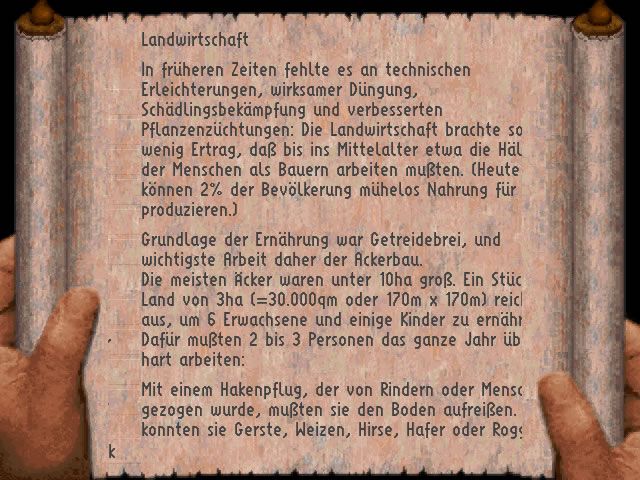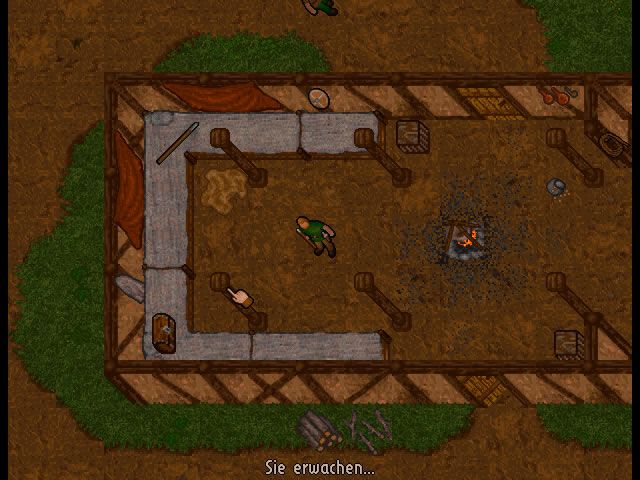Retro Replay Review
Gameplay
Teudogar and the Alliance with Rome offers a richly layered gameplay experience that balances open-world exploration with a deep narrative core. From the moment you step into your Teutonic city, you’re thrust into a dynamic world where every conversation, quest, and decision can shape the destiny of your people. Like the classic Ultima VII, the game’s isometric perspective gives you a clear view of your surroundings and an intimate sense of presence, whether you’re wandering through bustling Roman forums or dense Germanic forests.
(HEY YOU!! We hope you enjoy! We try not to run ads. So basically, this is a very expensive hobby running this site. Please consider joining us for updates, forums, and more. Network w/ us to make some cash or friends while retro gaming, and you can win some free retro games for posting. Okay, carry on 👍)
The freedom to choose your path is one of the game’s greatest strengths. You can devote yourself to forging an alliance with Rome—attending diplomatic meetings, negotiating trade agreements, and even learning Latin to navigate imperial politics. Alternatively, you may decide to unite the scattered Teutonic tribes against the encroaching empire, rallying warriors, forging war councils, and leading raids into Roman-held territory. This branching approach ensures high replay value, as each decision shifts alliances, questlines, and available resources.
Combat in Teudogar is turn-based, rewarding thoughtful strategy and careful positioning. Wounds sustained in battle carry realistic drawbacks: a deep cut to the leg can drastically reduce your character’s mobility, forcing you to consider retreating or seeking medical aid. This system adds tension to every clash and encourages investment in supporting skills like First Aid or herbalism. The “learning by doing” progression model further enhances immersion—swing your axe enough times, and you’ll wield it with expert precision, but neglect it for long and your proficiency can stagnate.
The interface is entirely mouse-driven, making navigation intuitive even for newcomers to the genre. Context-sensitive cursors highlight interactive objects, dialogue options are clearly displayed, and your journal automatically records key plot points and quest details. The in-game encyclopedia provides immediate access to historical context, character bios, and a bestiary, grounding your actions in the world’s lore while serving as an invaluable reference during complex quests.
Graphics
The visual design of Teudogar and the Alliance with Rome stands out for its meticulous attention to historical detail. Every piece of armor, every column in the Forum, and every carved god-statue in the Teutonic grove has been researched to match archaeological and textual sources from the age of Augustus. This dedication to accuracy creates a world that feels lived-in and authentic, inviting players to linger over the smallest environmental flourishes.
Character sprites are rendered in vibrant, hand-painted pixel art, capturing subtle expressions and period-accurate attire with surprising clarity. In the bustling market of Mogontiacum (modern Mainz), you can spot Roman merchants in togas bartering with Teutonic traders in furs, while legionaries in lorica segmentata patrol the streets. These little scenes come alive thanks to smooth animations—swaying banners, flickering torchlight, and horses’ coats that gleam in the sun.
The isometric perspective allows for expansive vistas without sacrificing detail. Scale the Palatine Hill and gaze across the River Tiber, noting the red roofs of temples and the white marble of new constructions commissioned by Augustus himself. Even in the dense woodlands of Germania, dappled sunlight filters through the leaves, and wildlife like deer and boar roam freely, adding to the sense of a dynamic ecosystem.
Special effects are used sparingly but effectively: a well-timed wildfire in a border camp sends embers drifting into the sky, and during pivotal story moments, subtle filters shift the color palette to heighten drama. These touches never feel excessive; rather, they underscore key narrative beats and remind players of the world’s living, breathing nature.
Story
At its heart, Teudogar and the Alliance with Rome is a tale of identity, loyalty, and the struggle between tradition and progress. You assume the role of Teudogar, a young warrior chosen by your tribe’s council to navigate this complex political landscape. Will you uphold the ancestral rites of your forebears, or will you embrace Roman innovations for the promise of peace and prosperity? Every dialogue choice carries weight, and even a seemingly minor remark about tribal customs can ripple outward, altering alliances or stirring rebellion.
The game’s branching narrative is bolstered by an extensive cast of characters. From the cunning Roman prefect with hidden agendas to the wise tribal elder torn between hope and fear, each NPC feels fully realized. Side quests range from rescuing kidnapped farmers in the frontier regions to retrieving rare manuscripts from a secluded villa in Ostia. These detours enrich the main storyline, exploring themes of cultural exchange, exploitation, and the price of empire.
Moments of quiet introspection sit alongside grand set-pieces. You might find yourself debating philosophical concepts in a candlelit study or leading a warband across a moonlit plain. Key story events are voiced with gravitas, and background music—blending Roman lyres with tribal drums—shifts dynamically to reflect your current allegiances. This seamless integration of narrative, performance, and sound design heightens emotional investment at every turn.
The in-game encyclopedia not only provides historical context but also deepens the narrative by revealing lesser-known facts about Roman law, tribal customs, and ancient religion. Consulting it can unlock new dialogue options or shed light on hidden motivations, making it more than a mere codex—it becomes a storytelling tool that rewards the curious mind.
Overall Experience
Teudogar and the Alliance with Rome excels at marrying historical authenticity with RPG freedom. Whether you’re a history buff eager to roam the streets of ancient Rome or a role-playing aficionado looking for a world shaped by player choice, this game delivers on both fronts. The depth of research is evident in every corner of the map, and the sandbox approach ensures that no two playthroughs feel identical.
While the learning-by-doing system and detailed wounds mechanics may challenge more casual players, they also foster a profound sense of growth and consequence. You’ll celebrate small victories—like mastering the gladius or successfully brokering peace between rival chieftains—and remember setbacks, such as a botched skirmish or a torn treaty, with equal clarity. These highs and lows forge a unique narrative arc that feels personal and memorable.
Performance across modern systems is generally smooth, though very large battles can cause minor slowdowns. The developers have been responsive post-launch, releasing patches to refine UI responsiveness and address rare quest-blocking bugs. The robust modding tools included at release promise even more content down the line, from new tribal factions to expanded Roman provinces.
In sum, Teudogar and the Alliance with Rome stands as a benchmark for historically grounded RPGs. Its blend of strategic depth, narrative nuance, and visual authenticity creates an immersive journey that will captivate both newcomers to the genre and seasoned veterans. If you’re ready to decide the fate of a people at the crossroads of history, this game offers an experience you won’t soon forget.
 Retro Replay Retro Replay gaming reviews, news, emulation, geek stuff and more!
Retro Replay Retro Replay gaming reviews, news, emulation, geek stuff and more!








Reviews
There are no reviews yet.